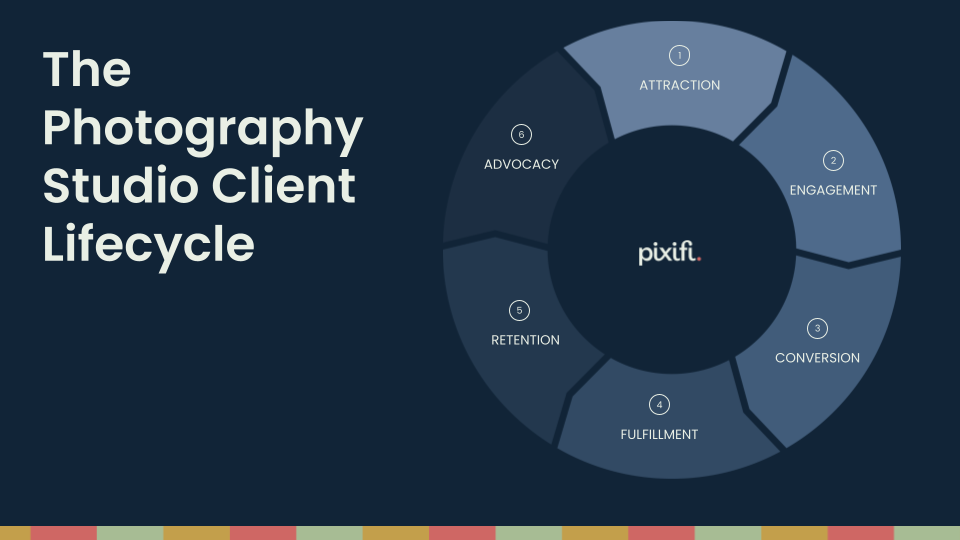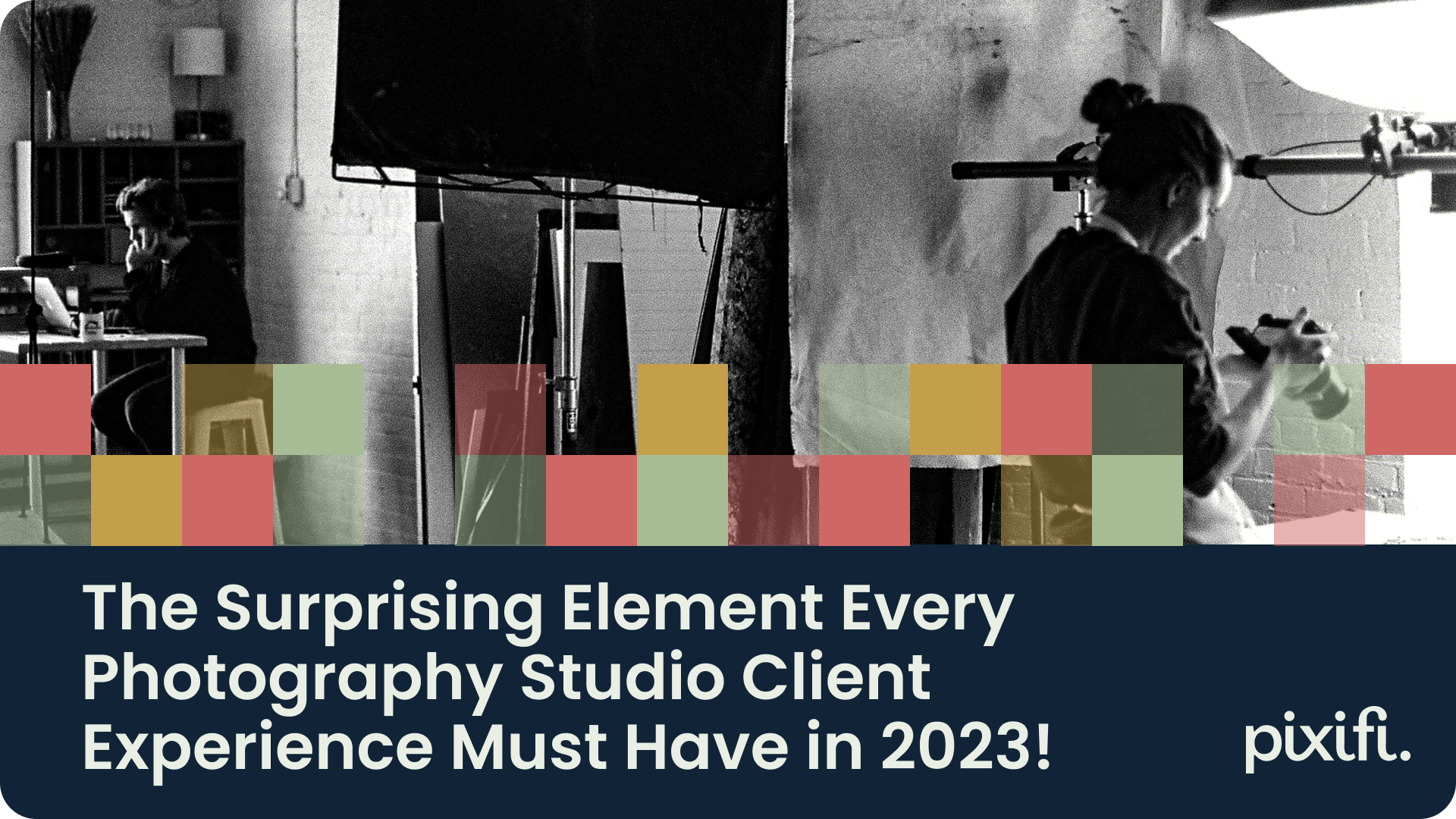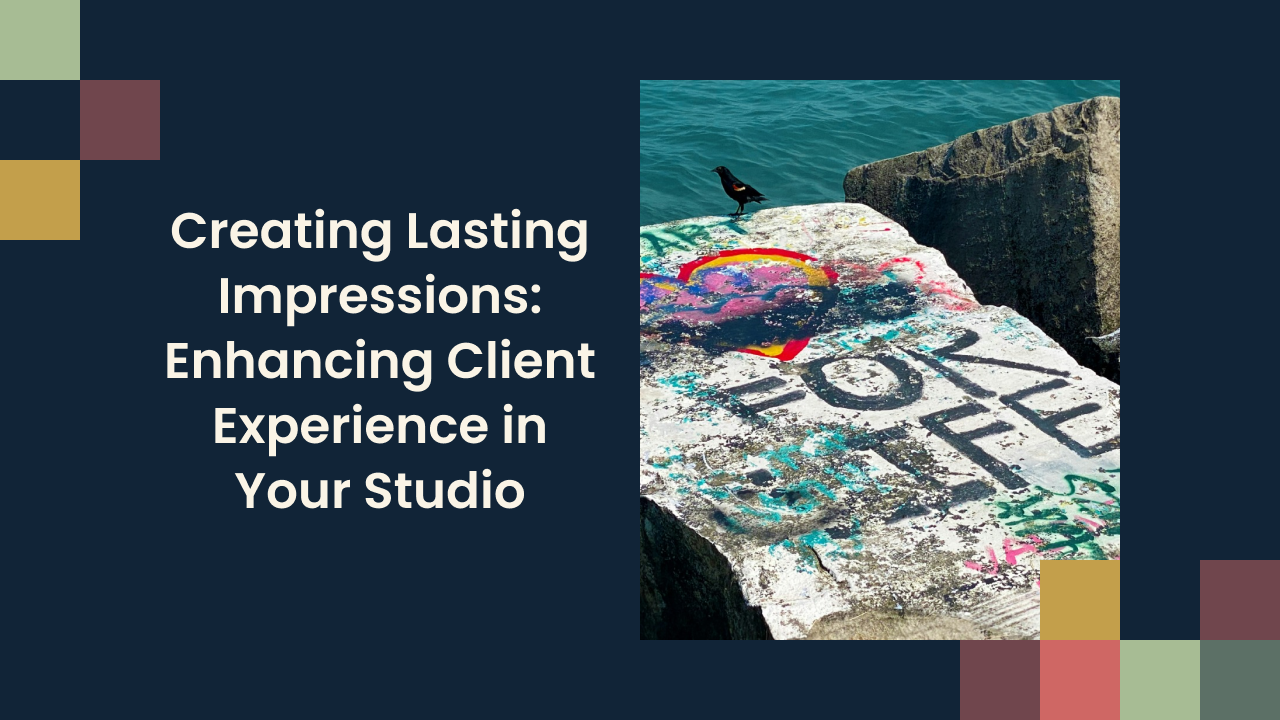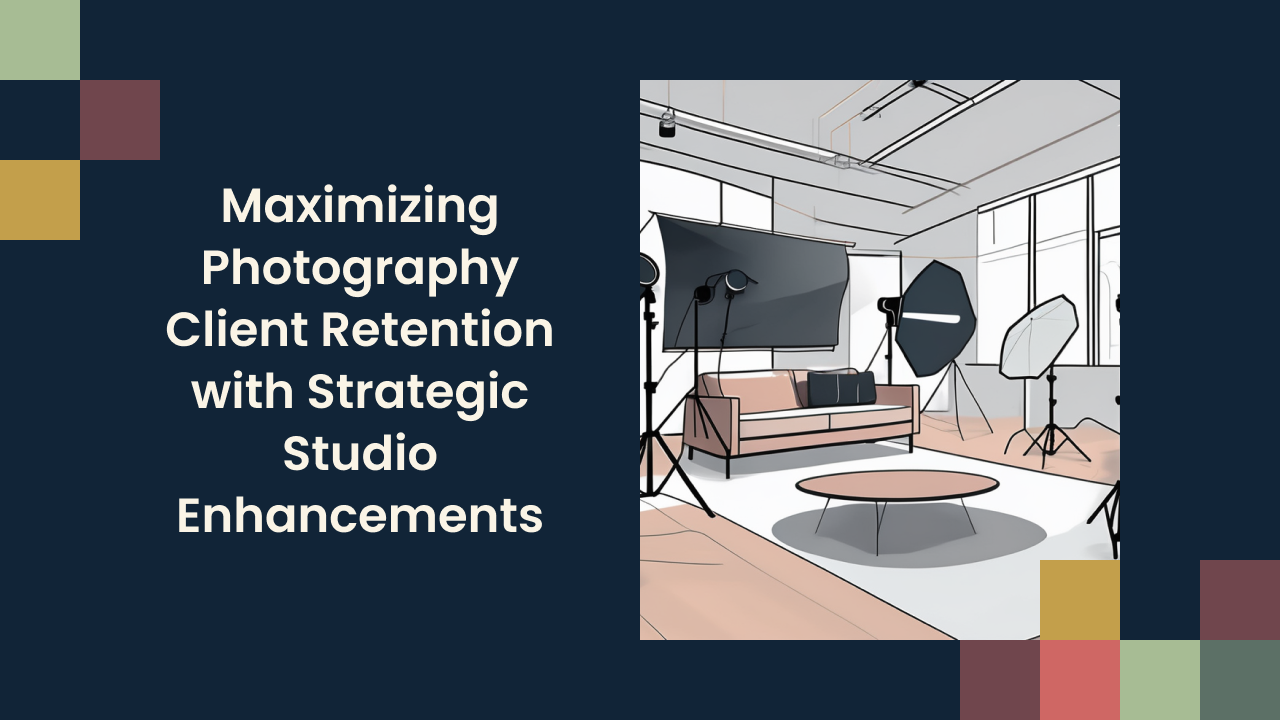Client Lifecycle Playbook: How Photographers Can Improve Leads, Service, and Retention
Running a successful photography studio takes more than just capturing beautiful images. It requires optimizing your entire client lifecycle – from that first inquiry to delivering exceptional service to nurturing relationships long after the shoot.
In this blog post, we’ll share key insights from The Foundational Framework: The Photography Studio Client Lifecycle webinar hosted by Pixifi, which brought together professional photographers to map out the client journey and discuss strategies to continually improve the client experience and studio operations.
The webinar was led by Kjael Skaalerud of Pixifi and featured a panel of photographers:
Jeramie Lu (Youtube // Instagram // Website) – A commercial, wedding, and portrait photographer based in Reno, Nevada. Jeramie focuses on showcasing personality and building relationships through his work.
Angie Nelson (Youtube // Instagram // Website) – A wedding photographer and owner of Engaged on Maui, a proposal planning and photography company in Hawaii. Angie leverages systems to deliver consistent, high-end experiences.
Maureen Sullivan (Website) – A portrait photographer and business consultant based in Massachusetts. She helps photographers worldwide implement systems for sales, productivity, and growth.
With decades of combined experience running studio operations, the panelists provided tactical tips and real-world insights into driving referrals, boosting retention, and exceeding client expectations throughout the customer journey.
Let's dive in!
TABLE OF CONTENTS
- Setting the Table: What makes the Client Lifecycle Framework useful?
- Quick Summary of the Client Lifecycle in the Context of a Photography Studio
- Say hello to our Panelists
- Stage-by-Stage Breakdown of the Client Lifecycle - Best Practice Advice & Tactics / Tools to Execute
- Bringing it all together: Utilizing Pixifi to Optimize Your Studio's Client Lifecycle
- Roundup of Key Takeaways
- Conclusion
- FAQs
- Additional Resources & Further Learning
Setting the Table: What makes the Client Lifecycle Framework Useful?
Taking a strategic approach to managing clients based on the customer lifecycle provides immense benefits for photography studio owners and operators. Adopting this framework allows systematic optimization of the entire client experience to accelerate growth.
Main Applications
The client lifecycle model provides a template for intentionally shaping customer engagements across the full relationship arc - from initial marketing to closing sales to retaining happy clients as brand evangelists.
Photographers can map core touchpoints and actions to each lifecycle stage as a checklist for success. This strategic approach ensures consistent execution and standards that delight clients.
Key Benefits
Structuring operations around the customer journey and not isolated transactions boosts sales, referrals and efficiency. Key benefits include:
- Increased lead conversion rates from improved sales processes
- Higher customer retention through exceptional service delivery
- More organic referrals by leveraging happy client networks
- Ability to identify issues and fine-tune specific lifecycle stages
- Predictable systems and workflows that scale the business
Mitigated Risks
Without an optimized client lifecycle, significant risks include:
- Losing sales due to poor lead follow-up and qualification
- Damaging your brand with inconsistent or unmet client expectations
- Alienating potentially loyal clients by "ghosting" them post-project
- Missed opportunities for client upsells, cross-sells, and referrals
As we delve deeper in the coming sections, we'll walk you through the nitty-gritty of the client lifecycle framework, one stage at a time by providing:
- Best Practice Insights from the Panelists
- General Business Practices & Useful Data Points
- Tactics & Tools to Execute
As a point of departure, let's establish some definitions for each respective stage of the client lifecyle.
Quick Summary of the Client Lifecycle in the Context of a Photography Studio

1. Attraction: The attraction stage involves generating brand awareness and interest among your target audience. Strategies include content marketing, social media, SEO, advertising, and PR. The goal is connecting with potential new leads.
2. Engagement: At the engagement stage, interested prospects interact with your brand by visiting your website, requesting information, or following you on social media. Now they become leads to nurture towards a sale.
3. Conversion: During conversion, leads make the decision to purchase from your business. This stage focuses on lead qualification, consultative selling, addressing concerns, and presenting proposals to turn prospects into customers.
4. Fulfillment: Fulfillment is when customers receive the product/service purchased. Excellence during delivery, meeting expectations, and providing support influence customer satisfaction and retention.
5. Retention: Retention involves nurturing relationships and driving repeat business from happy customers. Loyalty programs, customer feedback surveys, and ongoing communication are key.
6. Advocacy: Advocacy is the ultimate goal where delighted customers actively promote your brand through referrals, reviews, social shares, and repeat purchases.
We've now set the table and established definitions for key terms. Let's dive in!
A Quick 👋 Hello from our Panelists
Stage-by-Stage Breakdown of the Client Lifecycle - Best Practice Advice & Tactics / Tools to Execute
ATTRACTION
The pre-engagement stage is all about laying the groundwork to attract qualified, ideal clients. As panelist Maureen Sullivan noted, many photographers struggle to identify their ideal customer. But data shows clearly defining your target audience is essential. Segmenting and focusing your marketing efforts boosts conversion 25-30%, according to Forrester research.
Defining your ideal client
Don’t overcomplicate this. As the webinar host advised, look back on your best clients and identify common patterns. What was the typical project type, budget, personality factors, purchasing drivers, and overall fit? Document these specifics in an ideal client profile to laser target prospects just like them.
Panelist Angie Nelson has honed her ideal client for Engaged on Maui. She primarily works with men between ages 27-35 planning proposals in Hawaii who value expert local guidance. Defining this profile lets her tailor and qualify inbound leads. Clarifying who you want to work with - and avoid - is the foundation for an optimized client lifecycle.
Understanding your marketing channels
With your ideal client clear, audit what marketing channels and touchpoints they naturally engage with. Panelist Jeramie Lu focuses on referrals, search, and nurturing social media connections to organically attract his target customers.
Your website is the digital hub to tell your story and convert visitors into leads. Beyond that, monitor ROI and double down on channels yielding results. Jeramie emphasized bringing an authentic personal brand to platforms like YouTube and Instagram to resonate with wedding clients. Meet your audience where they already spend time.
GENERAL BUSINESS PRACTICES & USEFUL DATA POINTS:
Content is King: The Content Marketing Institute states that content marketing costs 62% less than traditional marketing and generates about 3 times as many leads. Quality content is not just king; it’s also a cost-effective way to attract clients. Regularly publish educational and entertaining content that addresses common questions and concerns of your target audience. It could be blog posts, webinars, or podcasts – anything that adds value and helps in building a connection with potential clients.
Hyper-Personalization is Key: According to a study by SmarterHQ, 72% of consumers only engage with personalized marketing messages. Tailoring your messages can significantly improve engagement rates. Tailor your marketing messages to address your target audience's specific needs and preferences. Leveraging data and analytics can help in understanding your audience better and crafting messages that resonate.
SEO Matters: According to a study conducted by Backlinko, the #1 result in Google’s organic search results has an average CTR of 31.7%. It is crucial to aim for high rankings to enhance visibility and click-through rates. Ensure your photography studio's website is SEO-optimized to attract more organic traffic. Use high-quality images and incorporate relevant keywords to improve your site's visibility on search engines.
TACTICS / TOOLS TO EXECUTE:
ENGAGEMENT & CONVERSION
The initial outreach and sales process sets the tone for the entire client relationship. Avoid turning leads into transactions. Instead, focus on consultative engagement that builds connections.
Importance of first impressions
First impressions stick. Studies show we form opinions about new people in milliseconds based on limited information. Panelist Jeramie Lu said competing on response speed is critical - data shows over 50% of buyers choose the first vendor to get back to them.
Automate instant responses when possible, but follow up personally. Provide just enough useful information to start a dialogue and schedule a call. Avoid info overload. Tailor follow up to each leads’ specific interests.
Lead qualification
Resist the urge to sell immediately before properly qualifying leads. Panelist Angie Nelson manually reviews inquiries before her office manager responds based on client profile factors like location. Qualifying questions and questionnaires filter out tire kickers while gathering key details from qualified prospects.
If budget or needs don’t align, “bless and release.” Don't waste time pursuing poor-fit leads. But closing sales isn’t the goal here - it’s starting positive relationships with qualified leads.
Consultative selling
Schedule quick video or phone consultations at this stage. Avoid endless email exchanges. Discuss needs, explain your full services, set expectations, address concerns, and build rapport.
Panelists stressed taking a consultative approach focused on fit and relationship first, not “selling packages.” Outline a roadmap for the next steps after gathering information to determine if mutual alignment exists.
Moving leads toward proposals
Once qualified and consulted, send configurable (vs customizable) proposals formalizing your offering, pricing, contract terms and booking details. This moves the relationship forward if both parties are ready.
Alternatively, many studios now directly schedule consultations and link to their booking page or online calendar from their website contact forms to filter unqualified prospects. Work towards proposals or bookings only when appropriate based on each lead’s journey.
GENERAL BUSINESS PRACTICES & USEFUL DATA POINTS:
Speed and Responsiveness are Non-negotiable: According to a lead response study conducted by Dr. James Oldroyd, the odds of making contact with a lead are 100 times greater when the lead is contacted within 5 minutes compared to 30 minutes. Essentially, the early bird catches the worm! Being quick to respond not only shows that you value the potential client’s time but also sets a positive tone for the engagement process. Harness tools like email automation, and chatbots (facebook, website) for instantaneous responses.
Educate to Build Trust: A study by Edelman reported that 81% of consumers need to trust the brand to buy from them. Therefore, positioning yourself as a trustworthy entity is pivotal. You can do this by sharing insights, tips, and educational content that adds value to your potential clients.
Simplicity and Transparency in Pricing: According to a study by Label Insight, 94% of consumers are likely to be loyal to a brand that offers transparency, highlighting the critical importance of straightforward pricing. Make your pricing structure simple and transparent. A clear breakdown of all the costs involved can help in building trust and encouraging the client to take the next step.
Testimonials and Reviews: A Spiegel Research Center report found that displaying reviews can increase conversion rates by 270%. Showcase reviews and testimonials prominently on your website. Positive reviews can significantly influence a potential client’s decision to choose your service.
TACTICS / TOOLS TO EXECUTE:
FULFILLMENT
With the contract signed, now you must flawlessly execute the photography services promised. The entire experience you deliver sets your brand apart.
Delivering consistent client experiences
To “wow” clients, identify key differentiators in your service approach and execute them consistently. Panelist Jeramie Lu ensures every wedding receives his special “Disney-style” treatment - anticipating needs proactively, solving problems behind the scenes, and focusing entirely on the client’s happiness.
Define your own service standards and train your team to uphold them. Follow up with clients regularly to manage expectations and surface any issues. Sweating these small details results in 5-star reviews.
Setting client expectations
Proactively set and manage expectations by providing clients with detailed timelines, shoot checklists, style guides and other resources well in advance.
Educate clients on how you work and what you deliver. For example, panelist Angie Nelson sends helicopter proposal clients extensive information on how to plan the perfect proposal. This facilitates a smooth experience. Share details and tips tailored to each booking.
Managing day-of execution
Carefully prepare for flawless day-of execution. Panelist Jeramie Lu sends questionnaires months prior to understand events and craft detailed schedules. He even has an assistant handle non-photography tasks so he can focus entirely on the client's needs.
Anticipate potential hiccups and have contingency plans ready so you can prevent or smoothly resolve them. Leverage tools like CRMs to manage all moving parts and requests. Outperforming expectations leaves an impression that sparks referrals.
GENERAL BUSINESS PRACTICES & USEFUL DATA POINTS:
Deliver More Than Promised: A report from Oracle found that 74% of customers have spent more due to excellent service, illustrating that exceeding expectations can lead to increased revenue. Always aim to exceed your client's expectations. Deliver a bit more than what was promised to leave a lasting impression.
Timely Communication: A study by Bain & Company showed that when companies engage and respond to customer service requests over social media, those customers end up spending 20-40% more with the company. Keep your clients informed about the progress of the project. Regular updates build trust and create a sense of reliability.
Flexibility and Adaptability: According to a report by Accenture, 91% of consumers are more likely to shop with brands who recognize them and provide relevant offers and recommendations. Be willing to adapt and make changes according to the client’s feedback during the fulfillment stage to ensure the end result is as per the client’s expectations.
TACTICS / TOOLS TO EXECUTE:
RETENTION
Your work doesn’t end once photos are delivered. Nurturing the relationship and proactively driving repeat business is critical for retention.
Getting client feedback
Send a follow-up survey to every client asking for honest feedback on their experience. Panelist Angie Nelson requests reviews and testimonials along with feedback to fuel continuous improvement. Solicit input during the image selection/editing process as well. This ensures you deliver images clients will love and gives insight into improving services.
Driving repeat business
Leverage your CRM to track key client dates and automatically “check in” to drive repeat sales. Panelist Maureen Sullivan schedules reminders to reach out around milestones like birthdays, anniversaries, etc. Build rapport with prompts like “We’re thinking of you!” Share unique deals and maintain top-of-mind presence so clients come back again and again.
Managing your online reputation
Actively encourage and monitor online reviews. These significantly impact purchase decisions - over 90% of consumers read them. Immediately address any negative feedback before it spirals. Panelist Angie Nelson prioritizes reviews and social proof in her market, given it is a destination and most clients find her via online search. Make it easy for clients to leave positive reviews on Google, Facebook, etc. Reviews reinforce your expertise and fuel referrals.
GENERAL BUSINESS PRACTICES & USEFUL DATA POINTS:
Feedback and Reviews: According to Microsoft, 77% of consumers view brands more favorably if they seek out and apply customer feedback. After the fulfillment stage, encourage clients to leave reviews and feedback and listen to their suggestions for improvements.
Loyalty Programs and Discounts: Accenture reports that 77% of consumers participate in a retail loyalty program, indicating the effectiveness of such initiatives in retaining customers. Introduce loyalty programs and offer discounts to repeat clients to encourage them to choose your services again in the future.
Regular Check-ins: Harvard Business Review reported that acquiring a new customer is 5 to 25 times more expensive than retaining an existing one, underscoring the importance of maintaining relationships with existing clients through regular check-ins. Periodically check-in with your past clients, sharing updates or simply wishing them on special occasions to keep the connection alive.
TACTICS / TOOLS TO EXECUTE:
ADVOCACY
Happy clients are the most valuable marketing asset. This final lifecycle stage focuses on generating referrals and upselling to nurture the relationship.
Leveraging happy clients
Loyal clients and raving fans provide organic word-of-mouth marketing. Panelist Jeramie Lu builds loyalty by giving vendors edited photos to drive referrals. Offer clients referral rewards or incentives to proactively recommend you. Even small thank-you gifts encourage referrals while making clients feel appreciated.
Automating follow-ups
Tools like CRMs allow automating personalized follow-ups at scale. Send event anniversary gifts, holiday offers, new service announcements, and more to stay top of mind. Panelist Maureen Sullivan stressed using systems to automatically trigger actions like requesting reviews at key points post-event. This maintains touchpoints.
Tracking client sources
Analyze ROI by monitoring which lead sources, marketing efforts, and lifecycle touchpoints convert at the highest rates. Then double down on what works. Panelist Maureen Sullivan highlighted using Pixifi reports to optimize marketing approach based on the customer data. Refine efforts to attract and retain your best client profiles.
GENERAL BUSINESS PRACTICES & USEFUL DATA POINTS:
Encourage Referrals: According to Nielsen, 92% of consumers trust referrals from people they know, making referral programs incredibly powerful. Encourage your satisfied clients to refer your services to their friends and family. You might even offer a referral bonus or discount to incentivize them.
User-Generated Content: AdWeek reported that user-generated content is 76% more trustworthy than branded advertising, highlighting its potential in building trust. Encourage clients to share their photos (shot by you!) on their social media, tagging your studio, which acts as a word-of-mouth marketing strategy.
Community Engagement: A report by CMX Hub showed that community-led companies see a 2x higher customer lifetime value, 2x higher NPS scores, and 3x faster growth. Build a community around your brand. Engage with your audience through social media, webinars, workshops, etc. and encourage your clients to become advocates for your brand.
TACTICS / TOOLS TO EXECUTE:
Bringing it all together: Utilizing Pixifi to Optimize Your Studio's Client Lifecycle
Roundup of Key Takeaways
The webinar covered a wealth of practical tips and best practices for optimizing the client experience at each lifecycle stage. Here are some of the top insights:
- Clearly define your ideal client. Analyze your best customers and craft a detailed “ideal client profile” to determine who you want to attract. This focuses your marketing and helps qualify leads.
- Compete on speed. Respond to inquiries instantly whenever possible. Studies show over 50% of buyers choose the vendor that gets back to them first.
- Streamline with automation. Use email templates, questionnaires, and automated workflows to qualify leads faster and deliver consistent experiences.
- Consult, don’t sell. Have real conversations to understand needs, set expectations, and build trust. Don’t jump straight to proposing packages.
- Set service standards. Identify key differentiators in your approach and execute them consistently to “wow” each client. Follow up proactively.
- Collect feedback. Ask for reviews and testimonials that can be used to build credibility with potential clients.
- Keep in touch. Leverage tools to track key dates and automatically check in with past clients to drive repeat sales.
- Offer referrals perks. Reward clients who refer new business with prints, albums or other small gifts to incentivize referrals.
- Analyze ROI. Track conversion rates, sales by source, and other metrics to continuously fine-tune your operations and marketing.
The panelists stressed the importance of seeing client relationships as ongoing and continuously optimizing the experience. With the right systems and deliberate follow-through, you can turn happy clients into lifelong brand evangelists.
Conclusion
Optimizing your client lifecycle is a key strategy for scaling your photography studio. By guiding clients through a positive journey from start to finish, you build a reputation for exceptional service. Satisfied clients drive referrals and repeat sales, fueling sustainable growth.
This webinar provided actionable tips directly from photographers who have honed the client experience. While every studio is unique, focusing on swift response times, consultative selling, consistent delivery, proactive follow-ups, and automation establishes a foundation for client success.
Fine-tuning your approach never stops as you analyze metrics and feedback. But aligning operations around the customer journey lets you continually improve.
We hope these insights from Pixifi’s client lifecycle webinar provided a blueprint to enhance engagement across your business. Be sure to check out the full recorded webinar for additional wisdom from our panelists Jeramie, Angie, and Maureen.
At Pixifi, our mission is to help photographers manage their operations so they can focus on what matters most – capturing incredible moments. If you’re looking to streamline your client lifecycle and grow your studio, you can start a free 2-week trial here.
FAQs
What systems do you recommend for managing client information and interactions?- Customer relationship management (CRM) systems like Pixifi are extremely useful for optimizing your client lifecycle. A CRM centralizes all your client data, correspondence history, bookings, invoices, and more to provide a 360-degree view of each customer. This enables you to deliver personalized service, automate workflows, identify upsell opportunities, and run insightful reports. CRMs save massive administrative time while facilitating stronger client relationships.
- The 80/20 rule generally applies - you want to devote 60-70% of your marketing and sales efforts towards nurturing existing clients, with only 30-40% spent on lead generation. Acquiring new customers costs 5-7x more than generating repeat sales and referrals from current happy clients. Upsell those who have worked with you before and leverage them to organically attract new leads through reviews and referrals. This maximizes your ROI.
- Key metrics to track include lead response time, lead-to-client conversion rate, repeat sales percentage, referral rate, retention rate after fixed time periods, client lifetime value, and client satisfaction scores. Analyzing these KPIs helps identify weaknesses in your lifecycle and opportunities to improve conversion and retention. You can then test changes and measure the impact.
- After a shoot, directly ask satisfied clients if they would mind taking a minute to leave an online review on platforms like Google, Facebook, WeddingWire, etc. Provide links and concise instructions for each to make it easy. Follow up again after delivering the final images. Offer small incentives like prints for 5-star reviews. This personal request is crucial for generating reviews.
- Strategically plan check-ins around major milestones - client anniversaries, birthdays, holidays, etc. Enter key dates into your CRM so you never miss an opportunity. Occasional “we’re thinking of you” gifts or personalized offers keeps you top of mind. Leverage automation so you can scale personalized outreach without adding major work.
Additional Resources & Further Learning
- Webinar Recording & Transcript - The Photography Studio Client Lifecycle
- Pixifi Blog - Regular articles on photography business operations, marketing, and productivity
- Understanding the Sales Funnel: A Comprehensive Guide - A detailed guide on understanding and optimizing your sales funnel
- The Photographer’s Guide to Marketing and Self-Promotion - A book by Maria Piscopo on marketing strategies for photographers
- SEO for Photographers: The Complete, Always-Updated Guide - A complete guide to SEO for photographers by Shotkit
- “Building Your Photography Business” by Christy Tuttle - An excellent book on strategically growing your photography studio
- CreativeLive - On-demand photography education courses for honing your craft
- PhotoShelter Guides - In-depth guides and ebooks covering photography marketing tactics
- “Best Practices for Professional Photographers” Course on LinkedIn Learning - Video course on photography business best practices
Looking for an easier way to manage and grow your studio? Experience a platform built by a photographer, for photographers. Try it free for 2 weeks.












